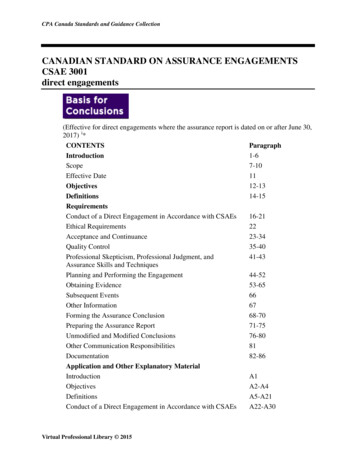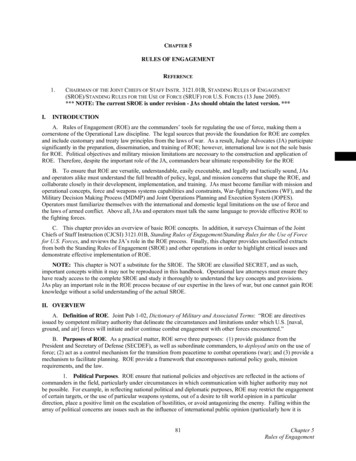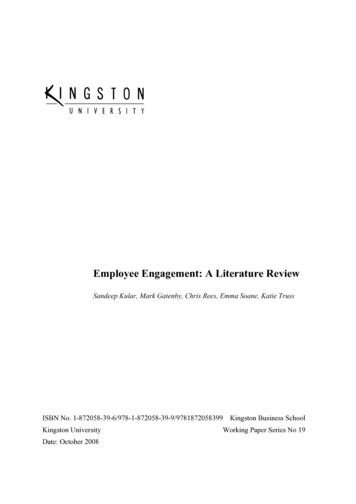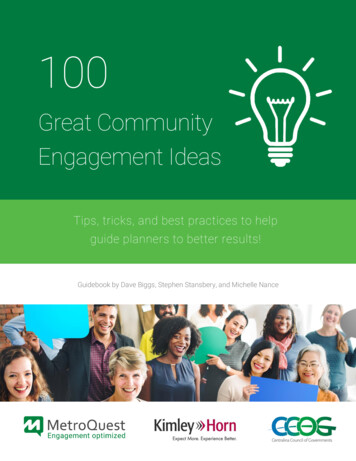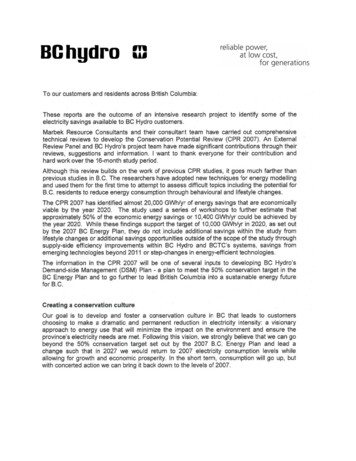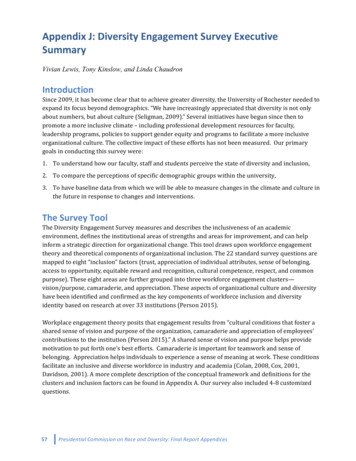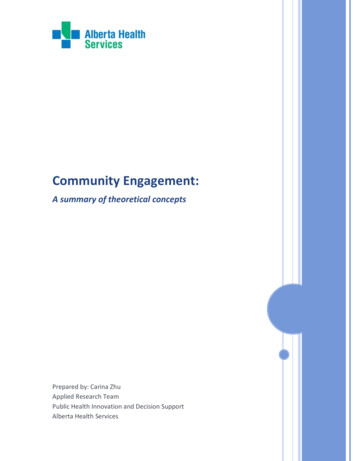
Transcription
Community Engagement:A summary of theoretical conceptsPrepared by: Carina ZhuApplied Research TeamPublic Health Innovation and Decision SupportAlberta Health Services
AcknowledgementsThe author would like to acknowledge the following individuals for their contributions:Dr. Deb McNeil, Charlene Mo, Shivani Rikhy, Dr. Lorraine Shack, Rosanna Taylor, andMarcus Vaska.Please direct questions/inquiries to:Carina Zhu RN MPHPublic Health Innovations and Decision SupportAlberta Health Services5th floor 2210-2nd Street SWCalgary AlbertaT2S 3C3Tel: 403-476-2527Fax: 403-355-3292Email: carina.zhu@albertahealthservices.caCommunity Engagement: A Summary of Theoretical Concepts - 1
Community Engagement: A summary oftheoretical conceptsExecutive SummaryAt the request of Cancer Screening Programs within Alberta Health Services, a high-levelreview of the literature was conducted to summarize community engagementapproaches that target community-based organizations, for the purpose of improvinghealth. Based on a review of an identified sample of articles, there were no engagementapproaches that solely targeted community-based organizations. Rather, involvingcommunity-based organizations was lauded as an important part of any approach toengage a community (Carlisle, 2010; Jabbar & Abelson, 201; Lane & Tribe, 2010; Pasick,Oliva, Goldstein, & Nguyen, 2010). The method through which community-basedorganizations are involved depends upon the answer to the question: what level ofengagement is required and for what purpose.One literature review suggested that the effectiveness of any community engagementapproach stipulated on the population and the health behavior (Swainston &Summerbell, 2008). Another review reported on the adverse impact an engagementinitiative can have on its participants (Attree, French, Milton, Povall, Whitehead, &Popay, 2011), such as causing physical, psychological, and financial stress. Findings fromprimary studies and position papers suggested that while different approaches andmodels exist for community engagement, the evaluation of these have been sparse orundocumented. Concepts such as diversity of stakeholders, deliberative methods forconsensus building, and equitable representation were identified as points for reflectionwhen designing and implementing a community engagement initiative. Based on thefindings of this report, it is recommended that:1) A community engagement approach should be tailored to the population ofinterest and the target health behavior2) Potential adverse effects of a community engagement initiative must beconsidered and mitigated3) Community-based organizations must be involved in any engagement initiative4) The inclusion of diverse stakeholders should not be at the expense of consensusbuilding5) Community engagement approaches should be evaluatedTaken together, the results of the summary may inform an engagement strategy to meetthe specific needs of Cancer Screening Programs.Community Engagement: A Summary of Theoretical Concepts - 2
BackgroundIn the spring of 2011, Cancer Screening Programs within Alberta Health Servicesarticulated a need to increase rates of breast, cervical, and colorectal screening amongethnically and culturally diverse Albertan populations. As part of an approved 3-yearproject funded by the Alberta Cancer Prevention Legacy Fund to increase and sustainrates of screening, the project recognized that communities must first be sufficientlyengaged. To this end, the project team requested a high-level review of the literature toidentify effective approaches to engage with community-based organizations that serveethnically and culturally diverse populations.The goal of this reportwas to summarizeengagementapproaches withcommunity-basedorganizations thathave resulted inimproved healthoutcomes.The decision to not limit the outcome of interest only torates of cancer screening was purposeful. In the case thatthere was little or no community engagement approachthat specifically targeted cancer screening, this widersearch would capture literature relevant to theethnocultural engagement context.Specifically, literature was gathered to answer thequestion: what approaches have been used to engagecommunity-based organizations serving ethnically andculturally diverse communities, for the purpose ofimproving health outcomes?MethodsTo identify academic articles, a search strategy was developed in consultation with aninformation scientist. The Academic Search Complete database1 was searched using thefollowing terms: public participation, community engagement, community participation,ethnocultural, ethnic group, and culture group. The search was limited to articlespublished between January 2001 and May 2011 with the major subject headings of“community-based programs” and “participation.” To identify pertinent grey literature,the same search was performed in Google, where the first 100 results were screened forrelevance2.1The database includes several electronic databases: CINAHL Plus with Full Text, Family Studies Abstracts, HealthBusiness Elite, Health Source – Consumer Edition, Health Source – Nursing/Academic Edition, MEDLINE, Psychologyand Behavioral Sciences Collection, Regional Business News, Social Work Abstracts, SocINDEX with Full Text, andUrban Studies Abstracts.2At the recommendation of the information scientist, the inclusion of the first 100 hits was meant to keep the resultswithin manageable limitsCommunity Engagement: A Summary of Theoretical Concepts - 3
Articles were screened at title, abstract, and full text for relevance to communityengagement. Articles were included if community engagement was discussed for thepurpose of improving health or health care services. Articles were excluded if discussionof community engagement was absent or if community engagement was not for thepurpose of addressing health outcomes. Results from relevant studies were synthesizednarratively.ResultsWhile literature on the topic of community engagement is expansive, only articlesrelevant to understanding community engagement for the purpose of improving healthwere included. Excluded literature discussed community engagement for the purpose ofaddressing environmental issues (e.g. cleaning up of oil spills, developing safe waterstrategy, mining, cultural planning, and urban planning). While these issues are alsointricately linked to health of the community, the focus was on the concept of advocacy,situated within politically charged settings where the relationship between the statutoryagency and the community has been tenuous. For this reason, these articles wereexcluded because of their limited ability to inform a community engagement approachwithin the context of the ethnocultural engagement project.The search for academic literature resulted in 109 hits with the aforementioned limitsapplied. Eleven articles were retained at full text. The Google-based search resulted in10 600 hits, of which the first 100 were screened, contributing 5 articles for this review.The total number of articles included for reporting was 16. Two were rapid reviews ofevidence, while the rest were primary studies or position papers.FindingsEvidence from two review-level studies is summarized first, followed by findings fromprimary studies and position papers.Review ArticlesSwainston and Summerbell (2008) conducted a rapid review of the evidence on theeffectiveness of community engagement approaches for health promotioninterventions. The two research questions were: What community engagementapproaches are effective for the planning, design, or delivery of health promotioninterventions? What are barriers to using community engagement and whatinterventions have successfully overcome these barriers? Studies were excluded if theydescribed secondary prevention interventions (e.g. screening programs), and if theytargeted individuals (as opposed to communities).Community Engagement: A Summary of Theoretical Concepts - 4
The following community engagement approaches were identified in the studiesincluded in Swainston and Summerbell’s review (2008): community coalitions,neighborhood committees, peer educators, school health promotion council, peerleadership groups, community champions, and community workshops. Theseapproaches were used to address several health domains, including cardiovascularhealth, childhood immunization, injury prevention, sexual health, smoking, alcohol,nutrition, and physical activity.The effectiveness of the community engagement approach depended both on the targethealth behavior as well as the community of interest (Swainston & Summerbell, 2007).For example, peer educators may be effective in improving vaccination uptake amongparents, but ineffective in preventing injury prevention in high risk youth (Swainston &Summerbell, 2007). Of particular relevance to the ethnocultural engagement team,community workshops used in the design and delivery of an intervention may facilitatesustained participation (Swainston & Summerbell, 2007).Barriers to community engagement included: centralized power in statutory sectororganizations, short-term funding, lack of infrastructure (e.g. no facilities for meetings),lack of trust from community/voluntary sector organization, and propensity for someorganizations to monopolize coalition groups (Swainston & Summerbell, 2008). Includedstudies did not identify strategies to mitigate these barriers.The authors’ cautioned that the included articles focused on evaluating theeffectiveness of the health promotion intervention rather than community engagement.This limited the usability of findings as it was difficult to ascertain whether identifiedimprovements in health were due to the intervention, the community engagementapproach, or both (Swainston & Summerbell, 2008).A second literature review addressed the impact of community engagement onparticipants of initiatives focused on social determinants of health (Attree et al, 2011).As such, articles in that review were drawn from multiple disciplines such as urbanrenewal, service planning, and civic participation.Community Engagement: A Summary of Theoretical Concepts - 5
Three main types of community engagement initiatives were found, with someinitiatives overlapping between categories (Attree et al, 2011):1) Area-based initiatives targeting social and economic disparities2) Person-based initiatives that aimed to engage marginalized populations3) Coalition-based initiatives aimed at harnessing power from interest groupsThe initiatives ranged in their level of engagement, from consultation, to delegatedpower in planning and design, to co-governance or co-production. Interestingly, none ofthe initiatives were controlled solely by community members (Attree et al, 2011).‘Engaged’ individuals reported positive changes in their physical health, psychologicalhealth, self-confidence, self-esteem, sense of personal empowerment, and socialrelationships (Attree et al, 2011). However, some adverse outcomes were also reported,such as exhaustion, stress, financial burden, consultation fatigue, and disappointment(Attree et al, 2011).Primary studies/position papersThree primary themes were identified from the findings from primary studies andposition papers, they are summarized accordingly:1) Approaches/models for community engagement2) Principles of community engagement3) Cautionary considerations in community engagementIt should be noted that there is some degree of overlap between these three categories,such that principles of engagement were also reflected in the articles that describedapproaches/models for engagement. Generally, articles that described principles ofengagement without suggestion of an approach or a model were summarized in theprinciples’ section.Approaches and models for community engagementThe articles discussed here span from theoretical discussions, to considerations forpractice, to those that encapsulate both. The inclusion of the theoretical documents waspurposeful, because they described approaches/models that were developed fromextensive field work. As such, there is confidence in the ability of theseapproaches/models to inform a community engagement initiative.Community Engagement: A Summary of Theoretical Concepts - 6
I. National Institute for Health and Clinical Excellence (NICE) recommendations &Community engagement with Black and Minority Ethnic (BME) communitiesThe National Institute for Health and Clinical Excellence in the United Kingdom(U.K) developed a set of 12 recommendations to guide effective communityengagement (2008). These recommendations were based on the analysis ofvarious types of data: reviewing government policies; systematically reviewingliterature on community engagement approaches and the experience ofcommunity engagement; modeling the economic cost of communityengagement; and incorporating program theory and evaluation principles (NICE,2008).Together, the recommendations cover four major components: prerequisites forsuccess, infrastructure to support implementation, approaches to support andincrease levels of community engagement, and evaluation. They are summarizedin the table below.Table 1: NICE Recommendations for Community EngagementRecommendationsCoordinate implementation of relevant policyinitiativesCommit to long-term investmentBe open to organizational and cultural changeBe willing to share power, as appropriate, betweenstatutory and community organizationsDevelop trust and respect among all those involvedSupport training and development of thoseworking with the community (including membersof that community)Establish formal mechanisms that endorse workingin partnershipSupport implementation of area-based initiativesUtilize community members as agents of changeFacilitate workshops in the communityConsult with residents of the communityEvaluate how community engagement approachesimpact health and social outcomesComponent addressed byrecommendation(s)Pre-requisites for successInfrastructure to supportimplementationSupporting/increasing level ofengagementEvaluationCommunity Engagement: A Summary of Theoretical Concepts - 7
Using the NICE recommendations, Lane and Tribe (2010) offered a four-steppractical guide based on their work with BME communities:Step 1:Making sureeveryone isreadyStep 2:ConsultingStep 3:Moving fromtalking toactionStep 4:Obtainingfeedback andfollow-upOne of the major tasks in Step 1 is finding a local organization that is willing andable to partner (Lane & Tribe, 2010). To avoid selecting an organization whoseviews may not reflect that of the greater community, the authors suggestedspending sufficient time within the community in order to decide whichorganization to engage with. While it is important to develop a meaningfulpartnership with a community, this process can be challenging for healthagencies. Indeed, barriers in access to and acceptance by communities mayhinder the early establishment of common goals. Other factors to considerduring this stage of the engagement include recognizing culture-specific beliefsabout health, ethical concerns, timing and commitment of consultation events,and interpretative services (if applicable).During the consultation phase, Lane and Tribe (2010) highlighted two essentialelements: 1) practical considerations – informing participants of what is requiredof them, and 2) frequency of consultation events. The authors advocated forone-to-one sessions with participants, wherever possible, over group sessions inorder to decrease domination of the outcome by community members who maybe opinionated (Lane & Tribe, 2010).II. Centre for Ethnicity and Health (CEH) Community Engagement ModelThe Centre for Ethnicity & Health in the United Kingdom, now known as theInternational School for Communities, Rights, and Inclusion (ISCRI), developed acommunity engagement model from their work with Black and minority ethniccommunities (Figure 1).Community Engagement: A Summary of Theoretical Concepts - 8
Figure 1: Center for Ethnicity and Health Community Engagement ModelSource: Fountain et al, 2007, pg. 5The aim of the model was to create an equitable environment in whichindividuals, organizations, and agencies can work together to address an issue ofmutual concern. There are several key ingredients to ensure the successfulimplementation of the model, including: A facilitator who will advertise, recruit, and select the communityorganizations to participate; provide and support a team of staff; andencourage inter and intra-community participationA host community organization that has good links to the targetcommunityA task that is meaningful, time-limited and manageable. It can be anyor all of the circles in the model diagram, linking communities andagencies in an equitable working relationshipTraining of community organization members as co-coordinators ofthe projectProject support worker(s) who provide support to the communities,as directed by the facilitatorCommunity Engagement: A Summary of Theoretical Concepts - 9
Funding support for project activities and personnelA steering group that should include local health service planners andprovidersThis model has been used by the Center for Ethnicity and Health in more than170 projects, with varying degrees of success (Fountain et al, 2007). However, itwas developed in the context of community based research and thecommunities were financially compensated for participation. The extent towhich compensation impacts the success of this model is unclear.III. Community Health Educator modelChiu (2008) described the use of a Community Health Educator (CHE) model(Figure 2) for engaging ethnic women from the United Kingdom in breast cancerprevention. Adapted from an action research framework, the model wasdeveloped on the principles of empowerment and capacity building.Figure 2: The Community Health Educator (CHE) modelStage 1 – ProblemidentificationFocus group, individualinterview, rapid appraisalworkshopsStage 2 – Constructing anintervention programStage 3 – Implementation,Monitoring, & EvaluationTraining CHEs to deliverhealthSupported bystakeholders and the hostorganizationReviewSource: Chiu, 2008, pg 152.IV. The CLEAN checklistMeade, Menard, Thervil, and Rivera (2009) used the CLEAN (Culture, Literacy,Education, Assessment, Networking) checklist to guide the engagement ofHaitian women in Florida, USA, for the improvement of breast health. Althoughthe checklist was intended to inform the process of health education, it alsoguided authors during the planning stage of the engagement process. As such,Community Engagement: A Summary of Theoretical Concepts - 10
these may be conceptualized as ‘prerequisites’ for success in communityengagement, within the context of the ethnocultural engagement project. Eachof the letters in the mnemonic tool is outlined below – Culture: what are some cultural beliefs within the community thatwould influence collaborative efforts to improve health?Literacy: How might language use, include low English proficiency,affect the engagement process? What would be the most appropriatemedium to mitigate potential community barrier(s)?Education: what educational materials and resources are available?Assessment: What culturally competent health initiatives currentlyexist? How may these be adapted to fit the current engagementprocess?Networking: What additional community services or resources existthat may augment the current engagement process?V. DeliberationScutchfield, Hall, and Ireson (2006) defined deliberation as a process that revealsunderlying values among similar and different points of view for consensusbased decisions. The process includes naming and framing the problem,deliberating about the problem, and determining the best solution to theproblem (Scutchfiled et al, 2006). To better understand the applicability of themodel, investigators interviewed Chief Executive Officers of eight national publichealth constituent organizations in the US to ascertain whether deliberation wasbeing implemented and what barriers, if any, exist.Overall, the respondents felt that deliberation was carried out to varying degreeswithin their organizations. Interestingly, most respondents equated deliberationto community engagement (Scutchfield et al, 2006), based on its ability to instillcommunity ownership over the issue and solution. A major barrier todeliberation included the concern that the deliberative process can furthermarginalize certain groups within the community if selection of participants wasnot thoughtful (Scutchfield et al, 2006). Another barrier was the potentialtension that can arise when the community identifies a problem different fromthe one the health agency would like to or is able to address (Scutchfield et al,2006). One major limitation of this study was the lack of information on theresponse rate, making it difficult to ascertain selection bias.Community Engagement: A Summary of Theoretical Concepts - 11
Abelson, Eyles, McLeod, Collins, McMullan, and Forest (2003) evaluated theeffectiveness of deliberative processes on prioritizing health goals. Deliberativeprocesses encourage dialogue between the community and the health agency,rather than a relay of information. Examples of deliberation methods includecitizens’ juries and focus groups (Abelson et al, 2003). Citizens’ juries are usuallycomprised of 12-16 people. The purpose of the jury is to examine an issue andmake a decision on how best to proceed after hearing from a range of speakers(Fountain et al, 2007). Focus groups are comparably smaller in size, ranging fromsix to 12 participants. The purpose of a focus group is to understand theperceptions, beliefs, and attitudes on a certain topic. A moderator facilitates thediscussion, and there is usually a set of pre-determined questions (Fountain et al,2007).According to Abelson et al (2003), deliberative methods are characterized by thefollowing attributes: The formation of a small group that is representative of thecommunity of interestSingle or multiple opportunities for face-to-face meetingsCommunication of relevant background information on the issueInvolvement of experts to answer participants’ questionsCo-production of a set of recommendations from the group’sdeliberationThe authors compared rankings of health priorities using three methods: mailsurvey, telephone survey, and a face-to-face meeting. They found that withincreased deliberation, participant views were more amenable to change(Abelson et al, 2003), illustrating the potential for deliberation to encourageconsensus building.VI. The LHIN frameworkJabbar and Abelson (2011) provided the lone community engagementframework developed within the Canadian context. Staff members from LocalHealth Integration Networks (LHIN3) in Ontario, Canada were recruited todevelop a community engagement framework.3LHINs are the Ontario-equivalents of the former regional health authorities in the province of AlbertaCommunity Engagement: A Summary of Theoretical Concepts - 12
Using a concept mapping approach, the participants identified six majorcomponents of a community engagement framework: Collaboration – working together to improve healthAccessibility – ensuring people have a voiceAccountability – health agency’s responsibilities to the communityEducation – supporting transparency and informationPrinciples – making engagement meaningfulOrganizational capacity – prioritizing community engagement withinthe health agencyBecause the study was explorative in nature, it lacked recommendations on howto operationalize the model.VII. The CTSI guide to community-engaged researchIn 2010, the Clinical Translational Science Institute (CTSI) at the University ofCalifornia San Francisco (UCSF) produced a manual for researchers to informcollaborations with community-based organizations (Pasick et al, 2010).Although it was meant to guide community engagement for the purpose ofconducting research, parts of the guide may be transferrable to communityengagement for the purpose of health services. In preparation for the initialconversation with community-based organizations, the authors suggestedconsidering the following questions: What interests do you have about the populations we serve?What do you want to accomplish?What makes your organization a good match for this project? Whatkind of help do you need?How will this project impact our work?Have you ever working with organizations similar to us before?What resources are available to support our participation?What kind of day-to-day and long-range decisions have to be made?What will the products of the research of our agency and for ourcommunity?Community Engagement: A Summary of Theoretical Concepts - 13
Principles of community engagementThe two papers summarized here include: 1) a theoretical discussion of principlesessential to meaningful participation, and 2) an evaluation of a teen pregnancyprevention program with implications for practice.Webler and Tuler (2002) suggested that there are two levels of enhanced publicparticipation: sustained deliberation and power sharing. At the first level, there is theopportunity for sustained deliberation, which has already been described in a previoussection. At the second level is the concept of power sharing, wherein a sense of jointownership over the issue and its solution is instilled. In order to achieve either level inpractice, the principles of fairness and competence must be adhered to (Webler andTuler, 2002).Fairness refers to what participants are entitled to, which includes the opportunity to bepresent, to make statements, to challenge/answer/argue, and to participate in decisionmaking (Webler and Tuler, 2002). Competence refers to having access to information,and using the best available procedures for knowledge selection. Types of knowledgemay include scientific facts, norms, or subjective claims (Webler and Tuler, 2002). Ifconsensus guides the decision making process, communities are more meaningfullyengaged and invested in the outcomes (Webler and Tuler, 2002). In other words,consensus is not necessarily required to make all decisions, but there must be mutualagreement on how disputes will be resolved (Webler and Tuler, 2002).In their evaluation of a teen pregnancy prevention program for African-Americancommunities in North Chicago, informality, flexibility, inclusion, and equity wereidentified as principles of community engagement that supported the success of theprogramming (Goldberg et al, 2011).The authors suggested that community partnerships, for the purpose of reducing healthdisparities, should be established at the conception of the project, involving diversegroups, and engaging health workers, as they often act as referral sources, advocates,recruiters, connectors, navigators, coaches, or data collectors (Goldberg et al, 2011).The authors further asserted that the engagement process should be cognizant offormal (e.g. executive director) and informal (e.g. case worker) leaders within thecontext of the organization. The consideration of both types of leaders is imperative tosustainability of partnership beyond engagement (Goldberg et al, 2011).Community Engagement: A Summary of Theoretical Concepts - 14
Cautionary considerations in community engagementThree case studies offered descriptions of practical challenges in communityengagement. Together, the findings can be categorized as cautionary insights thatshould be considered in the planning, design, and implementation of a communityengagement initiative.In their case study of the Community Partnership Network (CPN) in Greater Victoria,British Columbia, Schmidtke et al (2010) emphasized the critical role of the sociopoliticalcontext. The CPN consisted of community groups and stakeholders, aiming to developVictoria’s capacity to welcome and integrate newcomers into communities, workplaces,and organizations (Schmidtke et al, 2010).The recruitment of organizations into the network was based on previously establishedrelationships, which included two settlement agencies representing the immigrantcommunity. Authors suggested that this strategy perpetuated an existing unequaldistribution of power (Schmidtke et al, 2010). It may also have prevented the successfulinclusion of smaller ethnocultural community groups, thus limiting the reach of thenetwork (Schmidtke et al, 2010).Using the example of public participation in decision-making about health care, Dyer(2004) asserted that without clearly defining how community members should beinvolved and for what purpose, their potential contribution is diluted. Highlighting twotypes of knowledge needed to inform decision making: technical knowledge byscientists and phenomenological knowledge by the community, Dyer (2004) articulatedthat clarity of roles may facilitate meaningful participation of community members.Carlisle (2010) offered similar insights from the Social Inclusion Partnerships (SIPs) inScotland. With representation from community groups as well as local healthauthorities, SIPs were meant to address health inequalities using a partnership andcommunity-led approach. Recruitment of community representation proved to be acomplex and contestable process, as some community organizations felt that only aninterested minority would seek involvement, and certain groups, such as youth, willremain unrepresented. Furthermore, the health authorities’ emphasis on healthpromotion initiatives, like decreasing rates of smoking, was in disagreement with thecommunity groups’ priorities of creating more affordable housing (Carlisle, 2010). Thissuggests that depending on the project goal and scope, involving too diverse of partnersmay divert focus and impede consensus building. Finally, some communityrepresentatives exhibited hostile attitudes to others within their own communities,suggested that there is diversity and division by other demographics – age, sex, religion
Community Engagement: A Summary of Theoretical Concepts - 4 Articles were screened at title, abstract, and full text for relevance to community engagement. Articles were included if community engagement was discussed for the purpose of improving health or h
